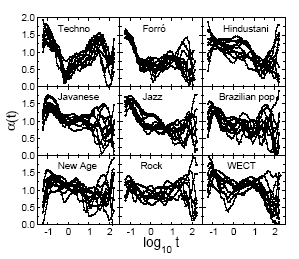Techno hits basic beat
January 7, 2004 | Source: Nature Science Update
Physicists have quantified differences in the patterns of various musical genres and their correlations to subjective, qualitative musical aspects of these genres by using a technique called detrended fluctuation analysis (DFA). DFA has been used to study complicated signals in economic, genetic and heartbeat data.
The method produces a number, “alpha,” that quantifies the complexity of patterns in a signal, in this case, the volume of music. Western classical and Hindustani music were found to be highest in loudness complexity (alpha approximately 1), closely followed by Javanese Gamelan and new age music, then jazz and rock and roll. Techno and Brazlian Forró were lowest because of their strong, regular rhythm, which is however, perfect for dancing.

Complexity of nine musical genres
The researchers also noted that studies of heart rate dynamics using the DFA method have shown that healthy individuals have values relatively close
to an alpha of 1, while subjects with heart disease have higher values (typically alpha > 1.2) that indicate a significant shift towards less complex behavior in heart rate fluctuations, since alpha = 1.5 corresponds to weakly correlated Brown noise (simulates Brownian motion and decreases in power by 6 dB per octave). As has been suggested, listening to certain kinds of music may conceivably bestow benefits to the health of the listener, they point out.
Variance fluctuations in nonstationary time series: a comparative study of music genres (preprint)